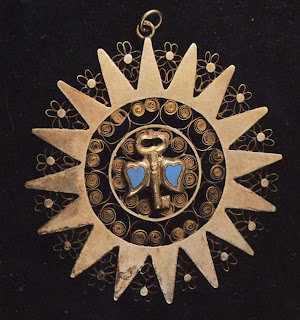Although there is no characteristic mask-figure in Abruzzo, there
are still various rituals and propitiatory customs connected with the
Carnival. Among these customs we must mention the dances known as "lu
saltarello" and the "lacci d'amore", a famous tradition at Sant'Andrea,
the smashing of cooking pots and the greasy pole.
In Guardiagrele on
the day of the carnival, people dresses in traditional clothes. Men
wear a hat with a flower into the band or are dressed as carnival
characters: the lawyer, the judge, the professor, the doctor, the
captain, the merchant. Local women goes to church dressed in traditional
long, black skirts with strips of brighter clothes and aprons, blouses
decorated with handmade lace, handmade wooden shawls, and gold pendants.
In Schiavi d’Abruzzo,
on the Carnival day, also known as “martedi’ grasso”, young men from
the village dress up in funny carnival clothes allwearing a huge paper
hat representing a bouquet of flowers and roses. These guys are called
Mazzaroni in local dialect, they stroll the streets of the village
singing, playing and dancing a traditional dance called La Spallata,
pushing each other shoulder against shoulder. They goes door to door
performing their amusing show and asking for sweets, food and wine.
In Molise, Carnival is characterised by an atmosphere that
takes back to Pagan rituals and is celebrated in a darker way than in
many other regions of Italy where it is characterised by colourful
masks, parades, amusing jokes and games. Molise celebrates the Carnival
in a deeplysymbolic way.
At Carpinone, Roccasicura and Forli del Sannio, the carnival puppet
“Fantoccio” is burned at the stake, in the main square of the village
where a huge fire burns in front of the villagers.
At Sant'Agapito the “Fantoccio” is thrown off a cliff. At Castelnuovo al Volturno near Rocchetta al Volturno
a man is dressed as a deer andis eventually caught by a hunter
performing ceremonial rituals. At Tutara there is the procession of the
devil.
The cheese game of Vinchiaturo
is something cheerer, in fact men competes in team by throwing large
rounds of cheese of 15 km down the streets. This competition is called
"Lancio della Ruzzola".
Source: Abruzzo Rural Property















